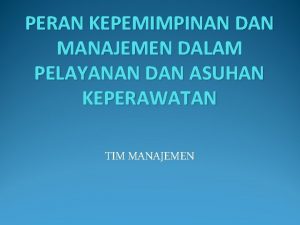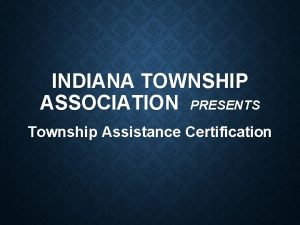Topics of Leadership Pequannock Township High School Q






















- Slides: 22

Topics of Leadership Pequannock Township High School Q 2013 -2014 Mr. Brady

Chapter 6 Leadership and Values “Leadership cannot just go along to get along… Leadership must meet the moral challenge of the day. ” ~Jesse Jackson

Leadership and “Doing the Right Things” Leaders face dilemmas that require choices between competing sets of priorities. l Leaders set a moral example to others that becomes the model for an entire group or organization, for good or bad. l This is NOT an individual choice l Morals guide your DECISION MAKING l l Leaders should possess a strong set of ethics, principles of right conduct, or a system of morals. Mc. Graw-Hill/Irwin 6 -3 © 2006 The Mc. Graw-Hill Companies, Inc. All rights reserved.

What Are Values? l Values are “generalized behaviors or ways of thinking that are considered by the individual to be important. ” l Values play a fairly central role in one’s overall psychological makeup and can affect behavior in a variety of situations. l They are not always related to the decisions that a leader makes. Mc. Graw-Hill/Irwin 6 -4 © 2006 The Mc. Graw-Hill Companies, Inc. All rights reserved.

The Relative Importance People Place on Values that have some sort of “end result” Values that are modes of behavior An exciting life Being courageous A sense of accomplishment Being helpful Family security Being honest Inner harmony Being imaginative Social recognition Being logical Friendship Being responsible Mc. Graw-Hill/Irwin 6 -5 © 2006 The Mc. Graw-Hill Companies, Inc. All rights reserved.

Leadership and “Doing the Right Things” (continued) l Two contrasting sets of assumptions people make about human nature: l Theory X l l Pessimistic view of others (discipline, pay, punishments) Assumes people are not naturally motivated to work l Theory l l Mc. Graw-Hill/Irwin Y Optimistic view of others (achievement, personal growth) Assumes people take pride in what they do 6 -6 © 2006 The Mc. Graw-Hill Companies, Inc. All rights reserved.

How Do Values Develop? l A person’s values reflect the contributions of: l Family l Peers l Educational system l Religion l Media l Science and technology l Geography l Current events Mc. Graw-Hill/Irwin 6 -7 © 2006 The Mc. Graw-Hill Companies, Inc. All rights reserved.

Generational Values l The results of a scientific sampling of over 1, 000 people living in the U. S. found little evidence of a generation gap in basic values for groups of people born at different times. l Values beyond those identified by the survey as “basic” are the result of education and life experience. Mc. Graw-Hill/Irwin 6 -8 © 2006 The Mc. Graw-Hill Companies, Inc. All rights reserved.

Four Generations of People l l There tend to be common value systems among people growing up at a particular time that distinguish them from people who grow up at different times. Each generation is molded by distinctive experiences during their critical developmental periods: l l The Veterans (1922 -1943) The Baby Boomers (1942 -1960) The Gen-Xers (1960 -1980) The Millenials (1980+) Mc. Graw-Hill/Irwin 6 -9 © 2006 The Mc. Graw-Hill Companies, Inc. All rights reserved.

The Veterans (born between 1922 -1943) l Veterans came of age during the Great Depression and World War II, and represent a wealth of lore and wisdom. l They’ve been a stabilizing force in groups for decades, even if they are prone to hanging onto “the good old days” 6 -10

The Baby Boomers (born between 1942 -1960) These were the postwar babies who came of age during violent social protests, experimentation with new lifestyles, and pervasive questioning of establishment values. l They like to think of always having the “solution” for a group, when in reality, sometimes they are the overbearing problem. l Boomers still have passion about bringing participation, spirit, heart, and humanity to their groups and collectives. l l They’re overly concerned about creating a level playing field for all 6 -11

The Gen Xers (born 1960 -1980) l Gen Xers grew up during the era of the Watergate scandal, the energy crisis, high divorce rates, MTV, and corporate downsizing. l As a group, they tend to be technologically savvy, independent, and skeptical of institutions and hierarchy. They are entrepreneurial and they embrace change. 6 -12

More about Gen. Xers l Having seen so many of their parents work long and loyally for one company only to lose their job to downsizing, Xers don’t believe much in job security. l l For them, job security comes from having the kinds of skills that make you attractive to an organization. They tend to be more committed to their vocation than to any specific organization Among the challenges they present at work is how to meet their need for feedback despite their dislike of close supervision. Xers seek balance in their lives more than preceding generations; they work to live rather than live to work. 6 -13

Generation “Next” (born since 1980) l This is your generation. In general, Nexters share an optimism born from having been raised by parents devoted to the task of bringing their generation to adulthood l l They are the children of soccer moms and little league dads. They doubt the wisdom of traditional racial and sexual categorizing, perhaps not unexpected from a generation rich with opportunities like having Internet friends that they can interact with at all times. 6 -14

How Values Impact Leadership Values are a primary determinant in how they define problems, or whether something even IS a problem. l Values often influence leader’s perceptions of individual and organizational successes as well as the manner in which these successes are achieved. l Values don’t normally help leaders choose right from wrong, and between ethical and unethical behavior. (Morals do) l Values develop early on in one’s life and, once established, may be relatively difficult to change. l Mc. Graw-Hill/Irwin 6 -15 © 2006 The Mc. Graw-Hill Companies, Inc. All rights reserved.

How Values Impact Leadership (continued) l Leaders tend to like followers with similar values and dislike those with dissimilar values. l l It is important for leaders to surround themselves with followers who possess divergent values. Leaders are motivated to act in ways consistent with their values, and they typically spend most of their time engaged in activities that are consistent with their values. Mc. Graw-Hill/Irwin 6 -16 © 2006 The Mc. Graw-Hill Companies, Inc. All rights reserved.

Key Work Values l Recognition “Be Center of Attention” l Tradition “Believe strongly in codes of conduct” l Power “Motivated to achieve and succeed” l l Hedonism “Have fun and entertain at work” l l Altruistic “Believe in helping others” l Affiliation “Value teams and networking” l Security “Like stability and predictability” Aesthetics “Place more importance on appearance” Science “Enjoy analyzing data” l Mc. Graw-Hill/Irwin Commerce “Motivated by financial success” 6 -17 © 2006 The Mc. Graw-Hill Companies, Inc. All rights reserved.

Leadership and Organizational Values l Research has shown that employees with values similar to the organization or team are more satisfied and likely to stay; those with dissimilar values are more likely to leave. “It’s important that people know what you stand for. It’s equally important that they know what you won’t stand for. ” ~Mary Waldrop Mc. Graw-Hill/Irwin 6 -18 © 2006 The Mc. Graw-Hill Companies, Inc. All rights reserved.

Leader Attributes and Behaviors Universally Viewed as Positive Trustworthy Positive Intelligent Just Dynamic Decisive Honest Motive arouser Effective bargainer Foresighted Confidence builder Win-win problem solver Plans ahead Motivational Administratively skilled Encouraging Dependable Communicative Informed Coordinator Team builder Excellence oriented Mc. Graw-Hill/Irwin 6 -19 © 2006 The Mc. Graw-Hill Companies, Inc. All rights reserved.

Leader Attributes and Behaviors Universally Viewed as Negative Loner Nonexplicit Asocial Egocentric Noncooperative Ruthless Irritable Dictatorial Mc. Graw-Hill/Irwin 6 -20 © 2006 The Mc. Graw-Hill Companies, Inc. All rights reserved.

Implications of Leadership Practitioners Interacting with individuals and groups holding conflicting values is inevitable. l Leaders in particular have a responsibility not to let their own personal values interfere with professional leader-subordinate relationships. l Mc. Graw-Hill/Irwin 6 -21 © 2006 The Mc. Graw-Hill Companies, Inc. All rights reserved.

Summary l Values are constructs that represent general sets of behavior or states of affairs that individuals consider to be important, and they are a central part of a leader’s psychological makeup. l Values impact leadership by which various attributes and behaviors are regarded differentially - positively or negatively. Mc. Graw-Hill/Irwin 6 -22 © 2006 The Mc. Graw-Hill Companies, Inc. All rights reserved.
 Brett charleston pequannock
Brett charleston pequannock Ispic
Ispic Southampton township school district
Southampton township school district Susquehanna township middle school
Susquehanna township middle school Boone grove athletics
Boone grove athletics Neptune township school
Neptune township school Heather pino-beattie
Heather pino-beattie Zlatožlutý sulfid
Zlatožlutý sulfid Lawrence township school board
Lawrence township school board Peran pemimpin dalam keperawatan
Peran pemimpin dalam keperawatan Hot topics in leadership
Hot topics in leadership Transformational vs transformative leadership
Transformational vs transformative leadership Adaptive leadership characteristics
Adaptive leadership characteristics Capable but cautious performer
Capable but cautious performer Thnen
Thnen Spatial association ap human geography
Spatial association ap human geography Easycbm old bridge
Easycbm old bridge Lyons township graduation
Lyons township graduation Ltrsd
Ltrsd Falls township police salary
Falls township police salary 780 turkeys live in merriam township
780 turkeys live in merriam township New sewickley township zoning map
New sewickley township zoning map Township and range definition ap human geography
Township and range definition ap human geography









































